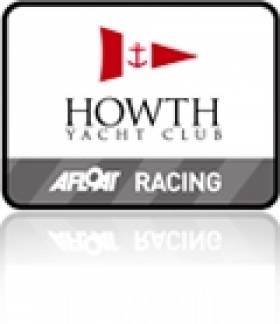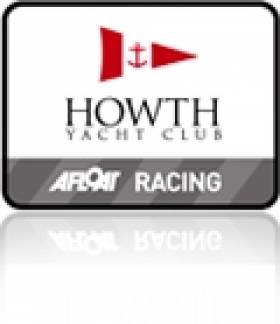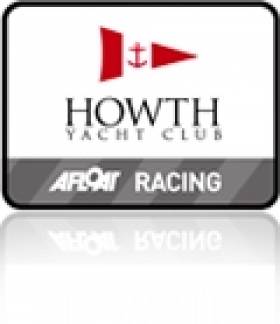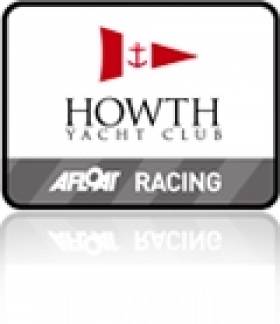Displaying items by tag: Squib National Championships
Cultra duo retain Squib national title at Howth
Ross Nolan and Gordon Patterson from the Royal North of Ireland YC are the 2011 Squib National Champions, retaining their title at Howth Yacht Club by five points in a 7-race series (sponsored by SIAC Construction) in which they were consistently in the top three of the 37-boat fleet.
Sailing ‘Quickstep III’, the Cultra duo took the trophy ahead of clubmates David Eccles and Philip Hutchinson in ‘Inshallah’ while a strong performance from Howth’s Fergus O’Kelly and Jonathan Wormald in ‘Whipper Snapper’ was rewarded with 3rd overall.
In stark contrast to the heavy conditions of the second day, the final race was delayed for over an hour until there was sufficient wind to start. Race Officer Derek Bothwell was later obliged to shorten the race which was won by the eventual series runners-up.
Another RNIYC boat, ‘Born Wild’ (T&J Anderson) was second with O’Kelly/Wormald in third but 5th for ‘Quickstep III’ was more than enough to see Nolan and Patterson deservedly top the series.
Howth’s Jonathan Craig and Hazel Ruane in ‘Kerfuffle’ will be well satisfied with 4th overall, a point ahead of Travellers’ Trophy winners Peter Wallace and Kerry Boomer in ‘Toy for the boys’ from Cultra.
SIAC Construction Irish Squib Championships at HYC – overall results:
- Quickstep III Ross Nolan/Gordon Patterson - RNIYC 14pts
- Inshallah David Eccles/Philip Hutchinson - RNIYC 19pts
- Whipper Snapper Fergus O’Kelly/Jonathan Wormold - HYC 21pts
- Kerfuffle Jonathan Craig/Hazel Ruane - HYC 26pts
- Toy for the Boys Peter Wallace/Kerry Boomer - RNIYC 27pts
- Sensation Marcus & Meagan Hutchinson - KYC 37pts
Squib National title stays in the North
Sailing ‘Quickstep III’, the Cultra duo took the trophy ahead of clubmates David Eccles and Philip Hutchinson in ‘Inshallah’ while a strong performance from Howth’s Fergus O’Kelly and Jonathan Wormald in ‘Whipper Snapper’ was rewarded with 3rd overall.
In stark contrast to the heavy conditions of the second day, the final race was delayed for over an hour until there was sufficient wind to start. Race Officer Derek Bothwell was later obliged to shorten the race which was won by the eventual series runners-up.
Another RNIYC boat, ‘Born Wild’ (T&J Anderson) was second with O’Kelly/Wormald in third but 5th for ‘Quickstep III’ was more than enough to see Nolan and Patterson deservedly top the series.
Howth’s Jonathan Craig and Hazel Ruane in ‘Kerfuffle’ will be well satisfied with 4th overall, a point ahead of defending champions Peter Wallace and Kerry Boomer in ‘Toy for the boys’ from Cultra.
SIAC Construction Irish Squib Championships at HYC – overall results:
- Quickstep III Ross Nolan/Gordon Patterson - RNIYC 14pts
- Inshallah David Eccles/Philip Hutchinson - RNIYC 19pts
- Whipper Snapper Fergus O’Kelly/Jonathan Wormald - HYC 21pts
- Kerfuffle Jonathan Craig/Hazel Ruane - HYC 26pts
- Toy for the Boys Peter Wallace/Kerry Boomer - RNIYC 27pts
- Sensation Marcus & Meagan Hutchinson - KYC 37pts
Tough conditions take their toll at Squib Nationals
Heavy winds and big seas played a major role on the second day of the SIAC Construction Squib National Championships at Howth Yacht Club with almost a third of the 37-boat fleet forced to retire with gear damage during the three races sailed.
Local boat ‘Whipper Snapper’ (Fergus O’Kelly/Jonathan Wormald) clearly revelled in the conditions to post two bullets and a 5th to move up to 5th overall while a first and two second places gives overall leaders Ross Nolan and Gordon Patterson of RNIYC in ‘Quickstep III’ a healthy 8 points margin after six races.
The day started perfectly for the Howth pair, finishing ahead of the pace-setters from Cultra and another RNIYC entry ‘Fagin’ (Michael & David Hill) and they finished on a high note by leading the same boat in the third race. In between, the Nolan/Patterson partnership took line honours ahead of clubmates David Eccles and Philip Hutchinson (Inshallah) and the leading Howth entry Kerfuffle (Jonathan Craig & Hazel Ruane).
The end result is that with just one race remaining on the schedule, Nolan and Patterson are virtually assured of the title, lying eight points clear of nearest challengers Eccles & Hutchinson, with Craig/Ruane and defending champions Peter Wallace/Kerry Boomer of RNIYC tying for 4th overall.
Tight at top of Squib Nationals after first day
It’s tight at the top of the leaderboard after the first three races of the SIAC Construction Squib National Championships at Howth Yacht Club today (Sat.30th), which saw three different race winners, each representing the three main Squib fleets. PHOTOS HERE.
Sailing in moderate south-easterlies that increased in strength as the day went on, the 37-boat fleet was led home in the first race by Howth’s ‘Kerfuffle’ (Jonathan Craig/Hazel Ruane) followed by ‘Ruby Blue’ (Aidan O’Connell/Sian McCleave) of the Royal St.George YC and then ‘Inshallah’ (David Eccles/Philip Hutchinson) of the Royal North of Ireland YC.
Defending champions Peter Wallace and Kerry Boomer of RNIYC in ‘Toy for the Boy’ showed the way in race 2, followed by ‘Inshallah’ and ‘Quickstep III’ (Gordon Patterson/Ross Nolan) to make it a Cultra 1-2-3.
The third race was won by ‘Ruby Blue’, with ‘Quickstep III’ in second ahead of ‘Fagin’ (Michael & David Hill, RNIYC) in third. Subject to protest, Aidan O’Connell has a one point advantage over Peter Wallace with Craig and Eccles joint third on 12 points.
Squib Nationals at Howth over Bank Holiday Weekeend
Howth Yacht Club hosts the SIAC Construction Squib National Championships over the Bank Holiday Weekend, with the biggest fleet in a decade – 36 and growing - contesting the 7-race series.
The 2010 National Champions, Gordon Patterson and Ross Nolan from the Royal North of Ireland YC, will be defending their title, with competition coming from clubmates Peter Wallace and Kerry Bloomer (winners of the Squib Traveller’s Trophy already), and also Aiden O’Connell and Sian McCleave of the Royal St.George YC.
The local Howth challenge will be headed by Emmet Dalton and Sé O’Leary in ‘Klipbok’ (who have narrowly missed out on a podium finish on several occasions) and Jonathan and Hazel Craig in ‘Kerfuffle’, who performed well in the recent UK Champs in Plymouth.

































































